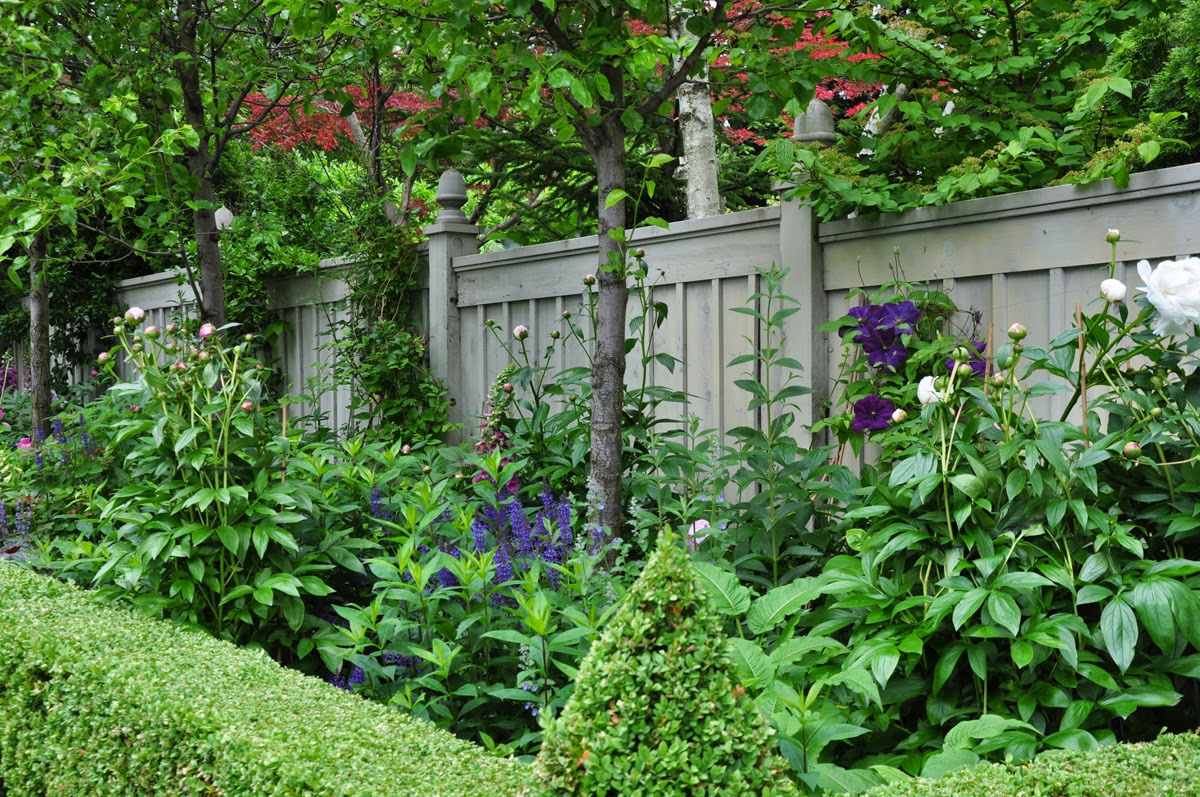We tend think of fencing primarily in terms of its function: it's ability to keep trespassers out while keeping children and pets in. A fence often forms the backdrop for any garden, so I thought it would be interesting to take a look at fencing's potential as a ornamental element in a garden.
There are lots of examples of creative and beautiful fencing in this post. Some require solid carpentry skills, but others like the double picket fence in my opening picture, are more about creativity and invention than they are about advanced skills with a hammer and saw.
This first example is hands-down one of the prettiest traditional fences I have ever seen. The arbor at the entrance is gorgeous too.
If you want something low and geometric, this is bow-tie design is traditional without being too cottage garden.
One drawback for all painted fences is the labor involved in their upkeep. Every three or four years the picket fence in my own garden needs to be cleaned, sanded and painted. It's hours and hours of work.
This is a fence that surrounds a country vegetable and herb garden. Notice that it isn't white, but dove-grey. The soft color is less contrasty than it would be, if the fence were bright white.
A few Common Types of Fencing Compared:
Wood:
• The quality of your fence will depend on the wood you choose. Some types of wood will hold up better over time than others.
• Wood is perhaps the easiest material for the home DIYer to work with.
• It is subject to rot and may have problems with pests.
• This is a type of fencing needs periodic maintenance.
• Wood can be painted or stained to suit your tastes.
Metal:
• Wrought iron is subject to rust and requires regular upkeep.
• Metal is a more expensive option than wood.
• Most of what passes for wrought iron these days is actually a lighter and less expensive form of aluminium, steel, composite or polymer materials.
Vinyl:
• Vinyl fencing is pretty maintenance free.
• It is easy to clean.
• Vinyl fencing may be more expensive to install than wood. The cost of maintenance over the long haul however, may be lower than some other types of fencing.
• There are now a greater range of styles and colors to choose from.
Bamboo:
• Bamboo is easy to install and cheaper than straight wood fencing.
• Bamboo is subject to rot and needs occasional maintenance.
• There are three types of bamboo fencing: bamboo cane, rolled bamboo and live bamboo.
Chain link:
• Chain link fencing is cheap and durable.
• Although you can add mesh or slats, it is not the best option for privacy.
• Chain link is not exactly the most aesthetically pleasing form of fencing.
I doubt that this fence keeps rabbits out, but it probably deters local deer from nibbling.
In the city, blocking traffic noise is always a goal. The best way to kept street noise out is to go with a solid fence of some kind.
What makes this fence particularly nice is all the detailing: the strapping on the sides of the fence and the acorn-shaped post toppers.
Before you build a Fence:
• Investigate local by-laws, building codes and zoning ordinances for restrictions on fence style and building materials, height restrictions and rules as to how far the fence must be kept from the property line.
• If you are planning a fence along your home's outer boundaries, have a professional land surveyor come in and do a proper survey that shows the property line, easements and setbacks so you know where you can build legally.
• Confirm with your local building department if you are required to apply for a building permit.
• Have your property marked for underground electrical, plumbing and other service lines.
And now for a few fencing options that are less formal. This split-rail fence is right at home in the countryside.
It doesn't get much more rustic than this. Metal post spikes support standard 4' x 4' poles. The cross pieces are simply long branches.
This gardener and her husband in Uxbridge, ON made the vegetable garden fence themselves.
"The fence is all cedar, " Carole tells me,"We had the cedar poles which we had collected in clearing some of our property. Then I cut fresh cedar saplings, trimmed the branches and bent them into the pattern I wanted and wired them in place. We each did a section in our workshop, and then we installed them separately."
Rabbits were an issue in this rural setting, so Carole and her husband placed wire fencing discreetly inside the decorative cedar one.
This is a willow wattle fence was made by artist Barbara Guy Long working with a team of assistants.
The structure is made with cedar posts and willow which is wattled or woven. (You can see more of this garden here: A Willow Garden in the Rolling Hills of Caledon, ON.)
Many thanks to Barbara's husband filmmaker and editor Garrick Filewod
One really great thing about working with a pliable material like willow is that it is possible to give a fence a fluid, organic shape.
I love the sweeping curves of this fence that Barbara created for the Belhaven Hospital in Dunbar, Scotland.
A couple of high-end fence options.
This Bamboo fence would be the perfect option of a Japanese style garden.
In this contemporary garden, the wood has been laid horizontally making for a neat striped effect.
Though we aren't looking to install any new fencing ourselves, the subject will certainly be on my mind when I sand and paint all the pickets on the front fence this spring. The classic white picket suits the house so perfectly, I can't imagine the garden without it.
Bookmark this post with a Pin.




























































